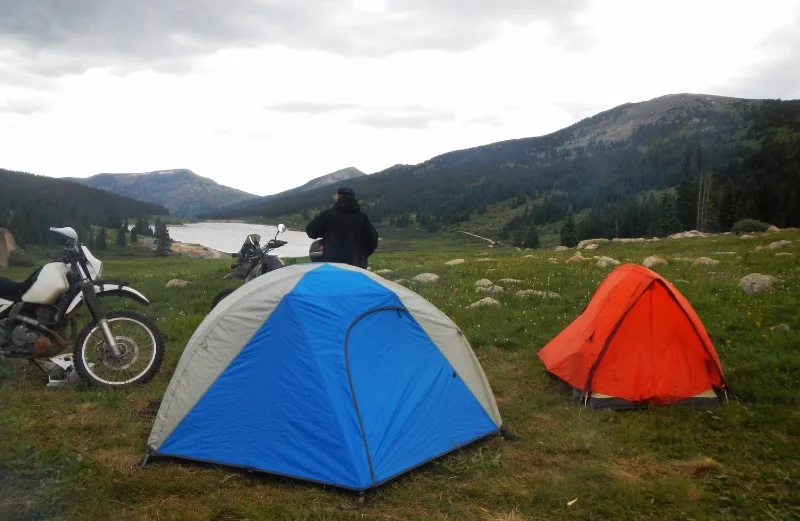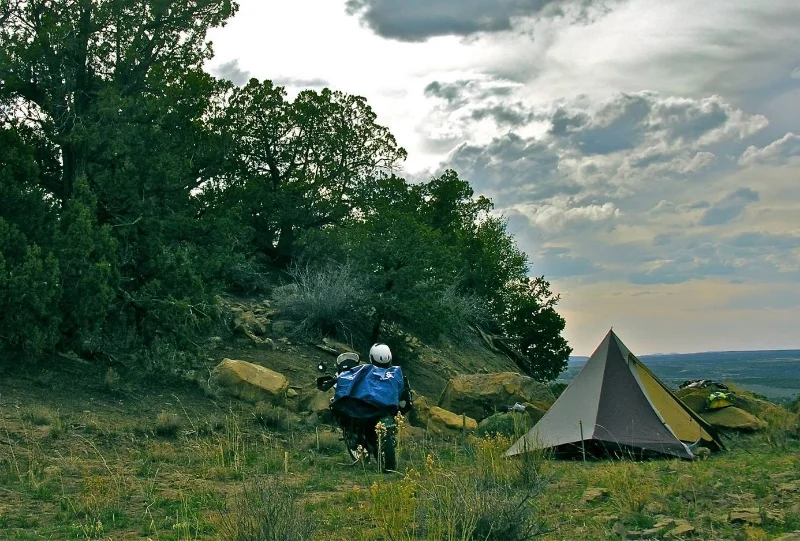When you decide to go motocamping, the first thing most people start thinking about is a shelter system. I call it shelter because there are options other than a tent. Only you can decide what is best for your adventure.
Things to consider
- Packable size and weight
If you are riding your motorcycle offroad size and weight make a huge difference in handling. Space is also limited on a motorcycle, especially if you are riding a smaller bike like a Yamaha WR250R or a Suzuki DRZ400. The only downside to finding a shelter that packs small and light is price. It is a wise move to spend as much as you can afford to keep your shelter small and light.
- Pole Configuration
Not all shelter systems need poles, but if you choose a system that needs poles try to pick a system that is as simple as possible. Gimmicks will cost more and leave you with a less reliable system. If something happens and you break a cheaply made pole you will have to figure out a way to make it work. Aluminum poles are both light and reliable. Good quality shelters will also include a splint to help repair a pole if you break one.
- Ease of use
When you have been riding all day and you are trying to set up camp in the dark or in the rain you will be glad you chose a system that is quick and easy to setup. If you choose to go for a tent, pick one that is self-standing. That way you can pitch your tent and easily move it to an ideal location. Any tent that requires guy lines to stand up will be more difficult to pitch.
- Capacity
Many riders have multiple shelters they can choose between based on the trip they have planned. Some riders prefer to go ultralight and use a hammock or a bivy. Other riders go the opposite way and opt for maximum room with something like a Redverz tent that is large enough to park your bike inside. Most riders choose a shelter that has capacity for an extra person so they will have room for gear.
- Gear Storage
If you want to shelter your gear from the elements there are several options. Some hammocks have ways to hang gear underneath. You can pick a tent that has extra room and some tents offer vestibules that make great gear shelters. Other riders may opt for something as simple as a tarp for gear. It is a wise choice to have some kind of gear shelter. The last thing you want in the morning is soggy boots or snow filled riding pants.
- Camping Locations and Conditions
Where you camp can have a lot to do with the shelter you choose. If you are camping in the desert a hammock is a poor choice since there are no trees. On the other hand, if you will be in a forested environment with uneven ground a hammock may be the best choice available. If you are camping in the snow you need a four season tent. It will keep you warmer and withstand the weight of snow better and high winds. If you are going to be in a very wet and rainy situation it would be wise to pick a tent that can be pitched with the rain fly first so you can keep your sleeping area dry.
- Ventilation and Rain Fly
Picking a shelter system with great ventilation prevents condensation from building up on the inside. The colder it gets the more condensation will build up. A sturdy rain fly that gives thorough coverage can make or break your experience if it gets wet. A quality rain fly setup is a good place to spend your money. With a single wall tent if the rain fly gets wet and starts to sag it may touch the inner tent. If that happens a leak could occur. A quality rain fly and tent design will have very little sag when it gets wet and there will be an adequate air space between the fly and inner tent.
- Color
This may seem trivial, but the color of your tent can make it more comfortable. If you have a light colored tent you will be able to see better when the sun comes up. Your headlamp will light it up better at night and you will be able to find it easier if you stray from camp at night. In fact, the only downside I can think of with a light colored tent is for reasons of stealth. If you are camping in a place where you may not have permission a color that blends with the surroundings may help you remain unseen.
- Taped Seams
Any high quality shelter will come with taped seams, but if you opt to purchase a cheap shelter make sure your seams are taped. Shelters will leak if the seams are not taped. On cheaper shelters you may need to do this yourself. No matter what, make sure they are taped before you go camping.
Breakdown By Styles
Bivy
Pros:
- Small and lightweight.
- Quick and Easy to setup and take down.
- Easy to find a camp spot where there isn't much open space.
Cons:
- Can feel restricting if you get stuck for a longer period of time.
- Not much room to shelter gear from the weather.
- Condensation can be a problem since there isn't much air space inside.
- Hard to change clothes or prepare meals inside the bivy.
- When it’s cold, the thicker clothing and heavier sleeping bags required can be tough to fit in a bivy.
Tips:
- Use a ground cloth to help protect your bivy from wet ground and thorns.
- If you have a tarp or poncho that can be pitched over the entrance to your bivy it can help keep water out of your shelter while getting in and out.
Example: Black Diamond Spotlight Bivy
Tent
Pros:
- Come in a variety of shapes, sizes, prices, and features.
- The most versatile of shelter types.
- Warm and comfortable.
- Enough room to be comfortable if the weather is bad.
- Enough room to protect your gear. Especially with options like vestibules.
Cons:
- Needs poles and stakes. These can be failure points.
- Some styles can be complex to pitch and may not be freestanding.
Tips:
- Choose a tent with a footprint available. It will extend the life of your tent and add extra water protection.
- Purchase the smallest, lightest tent you can afford that suits your needs. The weight and space savings will be worth it when you ride offroad.
- Choose a freestanding model.
- Look for features like vestibules for extra gear protection.
- If you will be sharing a tent with another person consider a model with two entrances.
Example: MSR Hubba Hubba NX
Hammock
Pros:
- Very small and lightweight.
- One of the most comfortable for sleeping.
- Quick and easy to hang and pack up.
- The most comfortable on uneven ground.
Cons:
- Can only be used where there are trees
- Can be cold in the winter since you have cold air underneath.
Tips:
- Make sure you have a good hanging system.
- Choose an option with a gear hanger underneath and a tarp above you.
- In the winter be sure to get an insulated sleep pad to help stay warm.
Example: ENO OneLink Hammock Shelter System
Specialty
This category is for the garage style tents like the Redverz.
Pros:
- Tons of room to protect all of your stuff.
- Plenty of room to stretch out in if weather is bad.
Cons:
- One of the largest and heaviest tents.
- More difficult to pitch and pack up.
- Not freestanding.
- Harder to find a suitable place to pitch your tent since you need a larger area.
Tips:
- Since guy lines are required, make sure you have some good stakes that work well for the terrain you will be camping on.
- Carry extra paracord to repair any guy lines.
- Share the tent with somebody. If you spread the load it will reduce the burden of the extra size and weight.
Example: Redverz Expedition II




